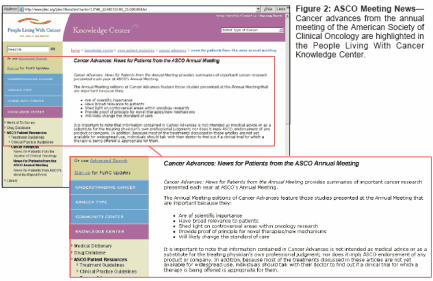Cancer Websites You Can Use:People Living With Cancer
People Living With Cancer(www.plwc.org, Figure 1), thepatient-oriented website postedby the American Society for ClinicalOncology (ASCO), has emergedas one of the preeminent cancer patienteducation sites, and for goodreason: It offers excellent site organization,easy navigability, and usefulinformation.
People Living With Cancer(www.plwc.org, Figure 1), thepatient-oriented website postedby the American Society for ClinicalOncology (ASCO), has emergedas one of the preeminent cancer patienteducation sites, and for goodreason: It offers excellent site organization,easy navigability, and usefulinformation.According to a note in the AboutUs section of the site, ASCO expertsreview all content, although who reviewedeach page is not specified;individual pages are not dated to allowthe user to check for currency.Another note points out that the sitesubscribes to the HONcode principlesof the Health on the Net (HON)Foundation, an international groupthat has promulgated medical informationsite quality standards. Pharmaceuticalsponsorship is tastefullydisplayed on the initial pages, withno evident impact on content and nopop-ups or overt advertising.Simple Organization
The site offers the option of generalcancer information or search bydiagnosis, leading to well-organizedpages with a simple overriding organizationalstructure.Searching by tumor type producesan appealing, easily read menu includingthe basics (eg, an introduction,risk factors and prevention,symptoms, diagnosis, staging, researchon the horizon, treatment)These basic informational sections arejust that-rather basic and limited tofairly generic descriptions, especiallyof treatments such as surgery, radiation,or chemotherapy. Some cancertypes have patient guides on specifictopics (for example, Tumor Markersfor Breast Cancer). The website consistsalmost entirely of text, withscarce graphics.Useful Integration
Other PLWC and ASCO site featuresare notably integrated, includinga News Center that links to recentReuter's health articles, ASCO resources,and other relevant organizations.Many physician resources areplaced at the patient's disposal, includingrecent ASCO lectures, physician-directed treatment guidelines, andsearchable ASCO abstracts.A section of the Knowledge Centercalled "Cancer Advances: Newsfor Patients from the ASCO AnnualMeeting" provides patient informationmaterial written about some ofthe more high-profile presentations(Figure 2). A "live chat"-each monthon a different cancer topic-is prominentlyfeatured on the home page,and previous chats are archived andavailable. One of the best site features,in the Understanding Cancersection, is the discussion of clinicaltrials from a patient perspective.


Other Features
Recently revised message boardsconveniently allow for multiple threadeddiscussions within topics (mostlyorganized by cancer types, but alsomore general cancer topics such as"coping with feelings" and "familyand friends"). Other site features includea medical dictionary link, a drugdatabase (which is long on side effectsand with which I had some navigationproblems), and an outstandingcompilation of cancer-related supportorganizations grouped by diagnosis.Many relatively uncommon tumorsare covered, including such rarities asEwing's sarcoma and carcinoid tumors.Indeed, this site does containextensive information, some of whichmay be hard to sift through to findrelevance to a particular disease. Forexample, the News Center containsall cancer-related Reuter's news. Theuser's best bet is to go with the diagnosis-related pages, where there hasalready been some sorting.In summary, PLWC is a goodsource of patient education, especiallyfor those who are already knowledgeableabout their disease and wantto use a website to keep up on thelatest advances. If you recommendthis site, however, be prepared to answerquestions, as it will put yourpatients in contact with a large volumeof physician-oriented information.In the News
The number of "cyberchondriacs"(those who go online to search forhealth-care information) appears to beplateauing.[1] After documenting in-creasesin the utilization of the Internetfor health-care information yearafter year since the inception of thepoll in 1998, the 2003 Harris Pollnumbers appear to have stabilized at52% of all US adults (and 80% ofregular online users). The poll wasconducted by telephone among a nationwidecross-section of over 1,000adults. The highest percentages of cyberchondriacsare found among collegegraduates (76%) and those withhousehold incomes above $75,000(79%).
References:
1.
Available at www.harrisinteractive.com/news/newsletters_healthcare.asp. AccessedAugust 5, 2003.
Newsletter
Stay up to date on recent advances in the multidisciplinary approach to cancer.
Oncology Peer Review On-The-Go: Cancer-Related Fatigue Outcome Measures in Integrative Oncology
September 20th 2022Authors Dori Beeler, PhD; Shelley Wang, MD, MPH; and Viraj A. Master, MD, PhD, spoke with CancerNetwork® about a review article on cancer-related fatigue published in the journal ONCOLOGY®.